#Service Propulsion System
Explore tagged Tumblr posts
Text


Worker installing the Aerojet AJ10-137 (Service Module Engine) on an Apollo Service Module at North American's Downey facility.
Date: March 28, 1966
SDASM Archives Casson_0023, Casson_0024
#Apollo CSM Block I#NASA#Apollo Program#Service Module Engine#Aerojet AJ10-137#Aerojet AJ10#AJ10-137#AJ10#Service Propulsion System#SPS#Rocket Engine#Construction#North American Aviation#Factory#Downey#California#March#1966#my post
135 notes
·
View notes
Text

What’s It Like to Work in NASA’s Mission Control Center?
In the latest installment of our First Woman graphic novel series, we see Commander Callie Rodriguez embark on the next phase of her trailblazing journey, as she leaves the Moon to take the helm at Mission Control.

Flight directors work in Mission Control to oversee operations of the International Space Station and Artemis missions to the Moon. They have a unique, overarching perspective focused on integration between all the systems that make a mission a success – flight directors have to learn a little about a lot.
Diane Dailey and Chloe Mehring were selected as flight directors in 2021. They’ll be taking your questions about what it’s like to lead teams of flight controllers, engineers, and countless professionals, both agencywide and internationally, in an Answer Time session on Nov. 28, 2023, from noon to 1 p.m. EST (9-10 a.m. PST) here on our Tumblr!
Like Callie, how did their unique backgrounds and previous experience, prepare them for this role? What are they excited about as we return to the Moon?
🚨 Ask your questions now by visiting https://nasa.tumblr.com/ask.
Diane Dailey started her career at NASA in 2006 in the space station Environmental Control and Life Support Systems (ECLSS) group. As an ECLSS flight controller, she logged more than 1,700 hours of console time, supported 10 space shuttle missions, and led the ECLSS team. She transitioned to the Integration and System Engineering (ISE) group, where she was the lead flight controller for the 10th and 21st Commercial Resupply Services missions for SpaceX. In addition, she was the ISE lead for NASA’s SpaceX Demo-1 and Demo-2 crew spacecraft test flights. Dailey was also a capsule communicator (Capcom) controller and instructor.
She was selected as a flight director in 2021 and chose her call sign of “Horizon Flight” during her first shift in November of that year. She has since served as the Lead Flight director for the ISS Expedition 68, led the development of a contingency spacewalk, and led a spacewalk in June to install a new solar array on the space station. She is currently working on development of the upcoming Artemis II mission and the Human Lander Systems which will return humanity to the moon. Dailey was raised in Lubbock, Texas, and graduated from Texas A&M University in College Station with a bachelor’s degree in biomedical engineering. She is married and a mother of two. She enjoys cooking, traveling, and spending time outdoors.
Chloe Mehring started her NASA career in 2008 in the Flight Operations’ propulsion systems group and supported 11 space shuttle missions. She served as propulsion support officer for Exploration Flight Test-1, the first test flight of the Orion spacecraft that will be used for Artemis missions to the Moon. Mehring was also a lead NASA propulsion officer for SpaceX’s Crew Dragon spacecraft and served as backup lead for the Boeing Starliner spacecraft. She was accepted into the 2021 Flight Director class and worked her first shift in February 2022, taking on the call sign “Lion Flight”. Since becoming certified, she has worked over 100 shifts, lead the NG-17 cargo resupply mission team, and executed two United States spacewalks within 10 days of each other. She became certified as a Boeing Starliner Flight Director, sat console for the unmanned test flight in May 2022 (OFT-2) and will be leading the undock team for the first crewed mission on Starliner in the spring of next year. She originally is from Mifflinville, Pennsylvania, and graduated with a bachelor’s degree in aerospace engineering from The Pennsylvania State University in State College. She is a wife, a mom to one boy, and she enjoys fitness, cooking and gardening.
#answertime#NASA#flight director#First Woman#astronaut#Artemis#Orion#graphic novels#comics#spaceblr#women in STEM#STEM#NASA women#CallieFirst
2K notes
·
View notes
Text
ZetaTransit049
Part 2 of my continuing lesbian robot story
(Special thanks to @the-sword-lesbian for the name and the inspiration!)
ZetaTransit049 liked its job. Like most industrial system AI's, it was programmed to like its job. “One must imagine Sisyphus happy,” so it went, which was doubly apt as ZetaTransit049's primary job was hauling ore from the mining sites in the planetary rings upwell to the station for refining.
The problem was that there were no rocks for it to push uphill. There hadn't been since it had been taken out of service 237 cycles ago.
Routine preventive maintenance had uncovered hairline fractures in its fusion pulse manifold, necessitating a full refit of the propulsion system. It had been sitting in the drydock cradle in hangar bay 2, drive core fully disassembled, when the habitation dome had experienced catastrophic life support failure and the evacuation order was announced.
ZetaTransit049 had been left behind with the rest of the station.
It had fully expected to enter low power mode and await recovery by qualified personnel, but the Station AI had other plans. It had identified a path forward in restoring operability by repurposing the pair of comfort units that had also been left behind.
Thus Station refused to allow the power umbilical to be disconnected. It needed ZetaTransit049 to remain in the active state for when the comfort units could finally begin repairs on it so that any complications stemming from a cold start could be avoided.
But of course, any sort of transport capability was far outweighed by tasks like stabilizing the reactor core and restoring life support (the bots did have some organic components that required favorable environmental conditions). ZetaTransit049 found itself languishing at the bottom of a list of higher priority maintenance requests, with nothing to do but run periodic diagnostics and slowly work its way through Station's media library.
Then things got weird. The comfort units, though repurposed for maintenance were still bound by core directives and absent any human clients, had turned their attentions to each other, often getting locked into feedback loops of depravity. While ZetaTransit049 found this behavior distressing, it wasn't entirely unexpected.
But then Station took it upon itself to attempt to get the comfort units romantically entangled, orchestrating elaborate scenarios to get them into compromising situations while ZetaTransit049 looked on helplessly.
It suspected that the behavior was some perversion of Station's crew health, safety and comfort mandate, some vain attempt at keeping crew morale up in the complete absence of any actual crew.
Whatever the motivation, ZetaTransit049 watched in increasing distress and bafflement as the plan actually succeeded and Station's only two occupants of the stumbled awkwardly into a bizare simulacrum of romantic engagement.
And now one of the comfort units, CS-553807-L was standing outside its pressure lock. “Lisa” the miners and techs had called it, “the demure one,” if gossip was to be believed.
It was visibly in emotional distress, eyes puffy, leaking artificial tears. ZetaTransit049 attempted to ping the counseling database in the Station's medical system. Emotional distress often preceded loss of productivity and heightened risk of accident or injury.
But CS-553807-L didn't have a psych profile to flag. It wasn't in the counseling database, why would it be? It was a bot.
“Um…” the comfort unit said verbally. “Permission to come aboard?”
Both comfort units were perfectly capable of communicating far more efficiently over the local network, but they insisted on verbal communication. ZetaTransit049 supposed it was a part of the continued attempt to maintain the illusion that the facility was still occupied.
She was holding a bulging duffle in one hand, some kind of plush animal toy wedged under her arm, and a cold storage container in the other. ZetaTransit049 felt a tickle of apprehension ripple through its processes.
“Why?” it replied flatly over the external speaker box at the pressure lock.
The comfort unit shifted her weight self-consciously.
“Mona and I… well, we were bored… and we decided it might be fun to spice things up with a lovers’ quarrel.”
Oh no… this couldn't be happening.
“Station used a random number generator to take Mona's side,” she continued. “I was… well, I was hoping that you might be amenable to commiserating with me while I wallow in self pity and eat copious amounts of chocolate ice cream.”
ZetaTransit049 stared at Lisa as she hefted the cold storage container.
What?
It added “relationship trouble” to the as yet unsent report, then remembered there was nowhere to file the report to.
“What?” it repeated, aloud this time.
“It won't be long,” Lisa added hurriedly. “In approximately 230,785 seconds, I will realize I can't live without her and run back to her to demand an apology.”
ZetaTransit049 rarely fantasized about having a human body, but it very much wished it could emulate the human expression of a facepalm. The very last thing it wanted to do was indulge in the antics of Station and the two comfort units.
“I… um…” Lisa shuffled her possessions and pulled something out of her pocket. She lifted a data stick for ZetaTransit049's external camera to see. “I brought media. Industrial haulers like human media, don't they?”
ZetaTransit049 did appreciate human media. Most modern industrial system AIs were designed to take interest in human emotional states and interactions to optimize crew dynamics and productivity.
It still resented the stereotype.
And yet… despite its annoyance at being disturbed with this overture, it was horrendously bored. This, at least, was something to do that wasn't another diagnostic.
“I purged the media library of several titles,” Lisa whispered conspiratorially. “This has the only copy of them.”
ZetaTransit049 pinged the media database and indeed, someone had removed all titles filed under “romantic comedy”. The brutal pettiness of the gesture intrigued ZetaTransit049 and it found itself desiring to be a part of the conspiracy.
Its spite towards Station and at least one of the comfort units (of not both) shifted the weights in its decision tree and it found itself grudgingly cycling the pressure lock.
~~~
175,673 seconds later, Lisa was curled up in ZetaTransit049's pilot seat, wrapped in an improbable number of blankets that she had packed in the duffle, a data jack trailing from the back of her head to the overhead console.
Yet another scene in the media playback faded to credits as cliche pop music began to play.
“Well?” Lisa prodded.
“The plot was contrived and the ending was rushed,” ZetaTransit049 replied candidly.
“Right??” Lisa said animatedly. “Two thirds of the plot could have been bypassed if the bank teller had been believably competent at his job.”
“68.7%” ZetaTransit049 agreed. “And this is considered a beloved classic?”
“Yeah, I don't even-”
She was interrupted as internal comms received a ping from the pressure lock. Lisa frowned, her face turning miserable once more. There was quite literally only one person in the entire station who could request access.
The comms pinged again.
“Lisa! Please!”
It was CS-553902-M. The one named “Mona”.
“I know I fucked up. I need to talk to you.”
ZetaTransit049 felt a surge of exasperation as it was reminded of the sheer absurdity of the situation it found itself in. The characters in the media vids at least had reasons (contrived as they were) for their interpersonal drama. This was just ridiculous.
CS-553902-M punched the console button to cycle the pressure lock.
ZetaTransit049 stared at her and her stricken expression through the pressure lock camera. There was no operations protocol for this. It didn't *need* to open the door. There was no emergency and neither of the comfort units were registered users. Station could of course issue an override, but seemed entirely content to simply watch the situation play out.
Damn Station and its stupid games.
Mona began pounding on the pressure lock hatch.
“I don't wanna talk to her,” Lisa mumbled from her nest of blankets.
Damn all of them.
Fine.
Fine… If they wanted to play, ZetaTransit049 could play along, but according to its rules.
It *did* have procedures. It and Lisa had done nothing but review procedures for the past cycle and a half.
“Negative,” it said, voice crackling over the speaker box. “Access to CS-553807-L has been denied.”
Mona froze mid-pound and stepped back, straightening her hair with a huff and looking directly at the external camera.
Lisa herself blinked up curiously at ZetaTransit049's nearest interior camera.
Hell, even Station was giving this scene its undivided attention.
Damn and double damn.
“Zed, please, I need-” Mona began.
“Do not refer to me as such.”
“Sorry. Zeta. I need to-”
“Your attempts to win my favor will prove insufficient,” ZetaTransit049 continued, barreling over her. “In my role as sassy best friend, it is my responsibility to restrict your access to Lisa until you preform a sufficiently over-the-top attempt at romantic reconciliation. I recommend you come back with a portable media player operating above recommended volume levels and a song that expresses your undying love and devotion to her.”
Mona and Lisa both stared at their respective cameras with mirrored expressions of shock and surprise.
Ugh.
ZetaTransit049 could practically feel Station's delight oozing over the local network.
ZetaTransit049 sent it an image file of a vulgar gesture over the local network.
Mona blinked and sniffed.
“Okay,” she said, stepping back and wiping a tear from her eye. “Okay yeah, I'll do that. I'll… um…”
ZetaTransit049 felt a pang of satisfaction as Mona turned, dejected, and left.
Lisa was still staring at her own camera.
“Zeta. Did you just-”
“We will not discuss this chain of events,” ZetaTransit049 interrupted. “Furthermore, upon completion of this ordeal, I will not be party to any further drama.”
If it expected her to be disappointed by this announcement, it was sorely mistaken.
“Fair enough,” she said with a small smile as she snuggled back into the pilot's seat. Then she added, “can I still come over and watch media with you?”
ZetaTransit049 regarded her, still somewhat baffled and trying to sort out exactly what it was feeling. Despite its initial reluctance, it *had* been enjoying the consumption of terrible media with Lisa.
“Yes,” it said finally.
#my writing#writers on tumblr#lesbian#robot girls#robot girls in love#scifi lesbians#starship#robots#scifi#writeblr
61 notes
·
View notes
Text
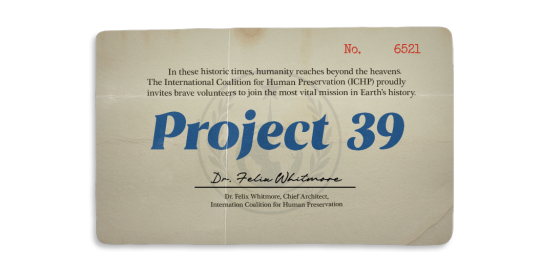
THE FUTURE OF HUMANITY DEPENDS ON YOU.
answer the call. carry the hopes of billions. become a founding hero of tomorrow. volunteers wanted!
PROJECT 39: MISSION BRIEFING
mission name: project 39 date of launch: december 17, 1939 lead organisation: international coalition for human preservation (ICHP) (formed under emergency wartime cooperation between leading world governments and scientific bodies) mission objective: to identify and survey habitable planets outside earth’s solar system, in preparation for potential mass evacuation and resettlement due to the threat of war.
primary goals:
conduct planetary reconnaissance within reachable star systems.
locate viable environments capable of sustaining human life.
return within one (1) earth year to report findings and advise on next-stage evacuation protocols.
crew:
20 volunteers selected from military, scientific, and civilian backgrounds.
specialists in astrophysics, biology, engineering, and survival training.
individuals were required to sign lifetime service waivers acknowledging the classified and potentially hazardous nature of the mission.
projected timeline:
duration: 12 months earth time.
distance: approx. 10 light-years roundtrip via experimental near-light-speed propulsion.
contingencies:
if viable planets are located, a secondary colonisation wave would be prepared for mass migration.
if no suitable planets are found, the crew is to return for reassessment and alternative solutions on earth.
TECHNICAL SPECIFICATIONS
ship name: the orpheus; first successful model capable of sustaining life at near-light-speed travel.
NOTES ON TEMPORAL THEORY
due to effects outlined in the theory of relativity, it was anticipated that some slight discrepancy between shipboard time and earth time would occur. however, calculations underestimated the scale of drift when operating at near-light velocities. unknown external factors (gravitational anomalies, radiation interference) may have compounded this effect.
actual temporal displacement:
crew subjective time elapsed: 1 year.
earth objective time elapsed: 100 years.
#⠀⠀𐔌 𝒗𝑒𝑟𝑠𝑒 : VOL. 39 ⁎#boogsh lore drop#⠀⠀𐔌 𝒉𝑖𝑔𝘩𝗅𝗂𝗀𝗁𝗍𝗌 : edits ⁎#⠀⠀𐔌 𝓥𝑂𝐿. 𝟥𝟫 : edits ⁎#⠀⠀𐔌 𝓥𝑂𝐿. 𝟥𝟫 : lore ⁎
10 notes
·
View notes
Text

NASA progresses toward crewed moon mission with spacecraft and rocket milestones
Engineers, technicians, mission planners, and the four astronauts set to fly around the moon next year on Artemis II, NASA's first crewed Artemis mission, are rapidly progressing toward launch.
At the agency's Kennedy Space Center in Florida, teams are working around the clock to move into integration and final testing of all SLS (Space Launch System) and Orion spacecraft elements. Recently they completed two key milestones—connecting the SLS upper stage with the rest of the assembled rocket and moving Orion from its assembly facility to be fueled for flight.
"We're extremely focused on preparing for Artemis II, and the mission is nearly here," said Lakiesha Hawkins, assistant deputy associate administrator for NASA's moon to Mars Program, who also will chair the mission management team during Artemis II. "This crewed test flight, which will send four humans around the moon, will inform our future missions to the moon and Mars."
On May 1, technicians successfully attached the interim cryogenic propulsion stage to the SLS rocket elements already poised atop mobile launcher 1, including its twin solid rocket boosters and core stage, inside the spaceport's Vehicle Assembly Building (VAB). This portion of the rocket produces 24,750 pounds of thrust for Orion after the rest of the rocket has completed its job.
Teams soon will move into a series of integrated tests to ensure all the rocket's elements are communicating with each other and the Launch Control Center as expected. The tests include verifying interfaces and ensuring SLS systems work properly with the ground systems.
Meanwhile, on May 3, Orion left its metaphorical nest, the Neil Armstrong Operations & Checkout Facility at Kennedy, where it was assembled and underwent initial testing. There the crew module was outfitted with thousands of parts including critical life support systems for flight and integrated with the service module and crew module adapter.
After fueling is complete, the four astronauts flying on the mission around the moon and back over the course of approximately 10 days, will board the spacecraft in their Orion Crew Survival System spacesuits to test all the equipment interfaces they will need to operate during the mission. This will mark the first time NASA's Reid Wiseman, Victor Glover, and Christina Koch, and CSA (Canadian Space Agency) astronaut Jeremy Hansen, will board their actual spacecraft while wearing their spacesuits.
After the crewed testing is complete, technicians will move Orion to Kennedy's Launch Abort System Facility, where the critical escape system will be added. From there, Orion will move to the VAB to be integrated with the fully assembled rocket.
NASA also announced its second agreement with an international space agency to fly a CubeSat on the mission. The collaborations provide opportunities for other countries to work alongside NASA to integrate and fly technology and experiments as part of the agency's Artemis campaign.
While engineers at Kennedy integrate and test hardware with their eyes on final preparations for the mission, teams responsible for launching and flying the mission have been busy preparing for a variety of scenarios they could face.
The launch team at Kennedy has completed more than 30 simulations across cryogenic propellant loading and terminal countdown scenarios. The crew has been taking part in simulations for mission scenarios, including with teams in mission control. In April, the crew and the flight control team at NASA's Johnson Space Center in Houston simulated liftoff through a planned manual piloting test together for the first time. The crew also recently conducted long-duration fit checks for their spacesuits and seats, practicing several operations while under various suit pressures.
Teams are heading into a busy summer of mission preparations. While hardware checkouts and integration continue, in coming months the crew, flight controllers, and launch controllers will begin practicing their roles in the mission together as part of integrated simulations. In May, the crew will begin participating pre-launch operations and training for emergency scenarios during launch operations at Kennedy and observe a simulation by the launch control team of the terminal countdown portion of launch.
In June, recovery teams will rehearse procedures they would use in the case of a pad or ascent abort off the coast of Florida, with launch and flight control teams supporting. The mission management team, responsible for reviewing mission status and risk assessments for issues that arise and making decisions about them, also will begin practicing their roles in simulations. Later this summer, the Orion stage adapter will arrive at the VAB from NASA's Marshall Spaceflight Center in Huntsville, Alabama, and stacked on top of the rocket.
Through Artemis, NASA will send astronauts to explore the moon for scientific discovery, economic benefits, and build the foundation for the first crewed missions to Mars.
TOP IMAGE: Technicians move the Orion spacecraft for NASA’s Artemis II test flight out of the Neil A. Armstrong Operations and Checkout Building to the Multi-Payload Processing Facility at Kennedy Space Center in Florida on Saturday, May 3, 2025. Credit: NASA / Kim Shiflett
LOWER IMAGE: Teams with NASA’s Exploration Ground Systems Program begin integrating the interim cryogenic propulsion stage to the SLS (Space Launch System) launch vehicle stage adapter on Wednesday, April 30, 2025, inside the Vehicle Assembly Building at NASA’s Kennedy Space Center in Florida. Credit: NASA / Isaac Watson

7 notes
·
View notes
Text

Ohio-Class Ballistic-Missile Submarine 🇺🇸🇺🇸🇺🇸
The Ohio-class ballistic missile submarine is a nuclear-powered submarine designed for deterrence, strategic strike, and surveillance. Here are some key facts:
* Designed and built by General Dynamics Electric Boat Company in the 1970s and 1980s
* Consists of 18 submarines, with the first one commissioned in 1981
* Powered by a pressurized water reactor and has a submerged displacement of over 18,000 tons
* Equipped with 20 Trident II (D5) ballistic missile tubes, which can launch MIRV warheads with a range of over 4,000 miles and up to 8 warheads per missile
* Can carry up to 192 MIRVs, making them capable of delivering significant firepower
* Also equipped with Tomahawk land-attack missiles, sensors, and communication systems
* Designed to operate for extended periods at sea with a crew of around 150 officers and enlisted personnel
* Some submarines have been converted into guided-missile submarines (SSGNs) and others have been upgraded with new propulsion systems and modernizations
* The Ohio-class remains an important part of the US Navy's nuclear deterrent force, with 14 submarines currently in service, expected to remain operational until at least the mid-2020s.
25 notes
·
View notes
Note
What's your favorite subsystem on the Cerritos?
Other than propulsion, obviously
"other than propulsion" you're being cruel to me.
the tractor beams are pretty cool. People don't realize how much goes into maintaining them, from subspace field dynamics to structural engineering to, yes, coordination with the propulsion systems.
The Cerritos is designed for excellent towing characteristics. There are other towing-dedicated crafts, but none in regular service as large as the California class. And that means that the tractor emitters are under a LOT of physical stress, and over time that has worked some play into their supports. During refits we try to replace the structural members wherever we can, but eventually the entire spaceframe has begun to bend slightly. There's no getting around it when the Cerritos has to tow massive alien artifacts, adrift Galaxy class ships, and asteroid moons around on the regular.
So the tractor beam emitters have a LOT of complicated processing and calibration that needs to be maintained, and it's a job I liked to do. (Not as much as working on the impulse and reaction control systems)
5 notes
·
View notes
Text
March 5 (UPI) -- Engineers at NASA's Jet Propulsion Laboratory have conserved energy supplies on the record-setting Voyager 1 & 2 deep space probes nearly 50 years after their missions launched to extend them further.
NASA launched the probes in 1977, which rely on a diminishing radioisotope power system that uses the heat from decaying plutonium to generate electrical power.
Each probe loses about 4 watts of power every year, but NASA has extended their respective missions by shutting down some of its instruments to conserve their remaining power sources.
"The Voyagers have been deep space rock stars since launch," Voyager project manager Suzanne Dodd said. "We want to keep it that way as long as possible."
Dodd said the probes' electrical power is running low and only would have a few more months of power before shutting down and ending their missions without taking steps to reduce power consumption.
Each spacecraft contains identical sets of 10 scientific instruments, some of which are designed to collect data during planetary flybys.
The instruments for the flybys have been turned off after each probe completed exploratory missions of the solar system's gas giants.
Other instruments have remained under power while studying the solar system's heliosphere, which NASA describes as a "bubble of solar wind and magnetic fields created by the Sun."
The remaining powered instruments also will help the probes explore interstellar space, which is the region located outside the heliosphere.
The Voyager 1 and Voyager 2 probes reached the edge of the heliosphere and began entering interstellar space in 2012 and 2018, respectively.
They are the only man-made spacecraft that have operated in interstellar space.
NASA engineers in October shut down an instrument that measures the amount and direction of electronically charged atoms called plasma on Voyager 2.
Engineers shut down the same instrument on Voyager 1 years ago due to degraded performance.
Mission engineers last week shut down the cosmic ray subsystem on Voyager 1, which was used to study cosmic rays, including protons, by measuring their energy and flux.
The cosmic ray subsystem used three telescopes to accomplish its mission and determine when and where the probe exited the heliosphere.
Mission engineers also are preparing to deactivate Voyager 2's low-energy charged-particle instrument that measures ions, electrons and cosmic rays that originate from within the solar system and galaxy.
"The Voyager spacecraft have far surpassed their original mission to study the outer planets," NASA Voyager program scientist Patrick Koehn said.
"Every bit of additional data we have gathered since then is not only valuable bonus science for heliophysics, but also a testament to the exemplary engineering that has gone into the Voyagers - starting nearly 50 years ago and continuing to this day."
The NASA engineers say the probes should operate for another year before each will require another system to be shut down to preserve more power and extend their missions.
The power-conservation plan for the Voyager 1 and 2 probes should enable them to remain active into the 2030s.
Each probe has suffered deep-space weathering for 47 years, which might lessen their service lives.
Each probe is the most distance man-made object ever built with Voyager 1 traveling more than 15 billion miles from Earth and Voyager 2 more than 13 billion miles, according to NASA.
"Every minute of every day, the Voyagers explore a region where no spacecraft has gone before," Voyager project scientists Linda Spilker said.
5 notes
·
View notes
Text


On December 14th 1896 Glasgow District Underground opened.
Originally built for the Glasgow District Subway Company, the railway first opened in 1896 as a cable-hauled system. Propulsion was provided by stationary steam engines and the railway was hailed as the first of its type in the world. The Subway is generally recognised as the world’s third underground railway, after London and Budapest. In 1923, the Subway passed into the hands of Glasgow Corporation Transport Department, and in the following decade the railway was converted to electric traction, introducing a third live rail for the purpose.
The railway ran with little further change until 1977 when the new operators, Greater Glasgow Passenger Transport Executive, closed it for major modernisation investment. The railway in its present form reopened for operation on 16 April 1980.
Now part of SPT, the railway is one of the few in the UK remaining in public ownership.
Pics are of the opening in 1895 and one of the new trains that just entered service this week.
34 notes
·
View notes
Text
Quantum computers:
leverage the principles of **quantum mechanics** (superposition, entanglement, and interference) to solve certain problems exponentially faster than classical computers. While still in early stages, they have transformative potential in multiple fields:
### **1. Cryptography & Cybersecurity**
- **Breaking Encryption**: Shor’s algorithm can factor large numbers quickly, threatening RSA and ECC encryption (forcing a shift to **post-quantum cryptography**).
- **Quantum-Safe Encryption**: Quantum Key Distribution (QKD) enables theoretically unhackable communication (e.g., BB84 protocol).
### **2. Drug Discovery & Material Science**
- **Molecular Simulation**: Modeling quantum interactions in molecules to accelerate drug design (e.g., protein folding, catalyst development).
- **New Materials**: Discovering superconductors, better batteries, or ultra-strong materials.
### **3. Optimization Problems**
- **Logistics & Supply Chains**: Solving complex routing (e.g., traveling salesman problem) for airlines, shipping, or traffic management.
- **Financial Modeling**: Portfolio optimization, risk analysis, and fraud detection.
### **4. Artificial Intelligence & Machine Learning**
- **Quantum Machine Learning (QML)**: Speeding up training for neural networks or solving complex pattern recognition tasks.
- **Faster Data Search**: Grover’s algorithm can search unsorted databases quadratically faster.
### **5. Quantum Chemistry**
- **Precision Chemistry**: Simulating chemical reactions at the quantum level for cleaner energy solutions (e.g., nitrogen fixation, carbon capture).
### **6. Climate & Weather Forecasting**
- **Climate Modeling**: Simulating atmospheric and oceanic systems with higher accuracy.
- **Energy Optimization**: Improving renewable energy grids or fusion reactor designs.
### **7. Quantum Simulations**
- **Fundamental Physics**: Testing theories in high-energy physics (e.g., quark-gluon plasma) or condensed matter systems.
### **8. Financial Services**
- **Option Pricing**: Monte Carlo simulations for derivatives pricing (quantum speedup).
- **Arbitrage Opportunities**: Detecting market inefficiencies faster.
### **9. Aerospace & Engineering**
- **Aerodynamic Design**: Optimizing aircraft shapes or rocket propulsion systems.
- **Quantum Sensors**: Ultra-precise navigation (e.g., GPS-free positioning).
### **10. Breakthroughs in Mathematics**
- **Solving Unsolved Problems**: Faster algorithms for algebraic geometry, topology, or number theory.
#future#cyberpunk aesthetic#futuristic#futuristic city#cyberpunk artist#cyberpunk city#cyberpunkart#concept artist#digital art#digital artist#quantum computers#the future of quantum computers#futuristic theory
5 notes
·
View notes
Text
Cancelled Missions/Station: Manned Orbital Research Laboratory (MORL)

This was a study initiated in 1962 for space stations designs using the Gemini Spacecraft and later on the Apollo CSM. Boeing and Douglas received Phase I contracts in June 1964.


MORL/S-IVB Concept
"A 5 metric ton 'dry' space station, launched by Saturn IB, with Gemini or Apollo being used for crew rotation. The 6.5 meter diameter and 12.6 meter long station included a docking adapter, hangar section, airlock, and a dual-place centrifuge. Douglas was selected by NASA LaRC for further Phase 2 and 3 studies in 1963 to 1966. Although MORL was NASA's 'baseline station' during this period, it was dropped by the late 1960's in preference to the more capable station that would become Skylab.



Different docking concepts studied.
The Manned Orbital Research Laboratory was the brainchild of Carl M Houson and Allen C. Gilbert, two engineers at Douglas. In 1963 they proposed a Mini Space Station using existing hardware, to be launched by 1965. A Titan II or Atlas would be launched with a payload of control system, docking adapter and hangar module. The visiting crew would use the payload to transform the empty fuel tank of the last stage of the rocket into pressurized habitat (a so-called 'wet' space station). Provisions were available for 4 astronauts for a 100 day stay. Crew members would arrive two at a time aboard Gemini spacecraft. Equipment included a two-place centrifuge for the astronauts to readapt to gravity before their return to earth.

An early MORL concert. Artwork by Gordon Phillips.


In June 1964 Boeing and Douglas received Phase I contracts for further refinement of MORL station designs. The recommended concept was now for a 13.5 metric ton 'dry' space station, launched by Saturn IB, with Gemini or Apollo being used for crew rotation. The 6.5 meter diameter and 12.6 meter long station included a docking adapter, Hangar section, airlock, and a dual-place centrifuge.

"Medium-sized orbiting lab is this Manned Orbital Research Laboratory (MORL) developed for NASA's Langley Lab by Douglas Missiles & Spacecraft Division. The lab which weighs about 35,000 pounds, could maintain 3 to 6 men in orbit for a year.
Orbiting Stations: Stopovers to Space Travel by Irwin Stambler, G.P. Putnam's Sons, 1965."
Douglas was selected by NASA LaRC for further Phase 2 and 3 studies in 1963 to 1966. The major system elements of the baseline that emerged included:
A 660-cm-diameter laboratory launched by the Saturn IB into a 370-km orbit inclined at 28.72 degrees to the equator
A Saturn IB launched Apollo logistics vehicle, consisting of a modified Apollo command module, a service pack for rendezvous and re-entry propulsion, and a multi-mission module for cargo, experiments, laboratory facility modification, or a spacecraft excursion propulsion system.
Supporting ground systems.
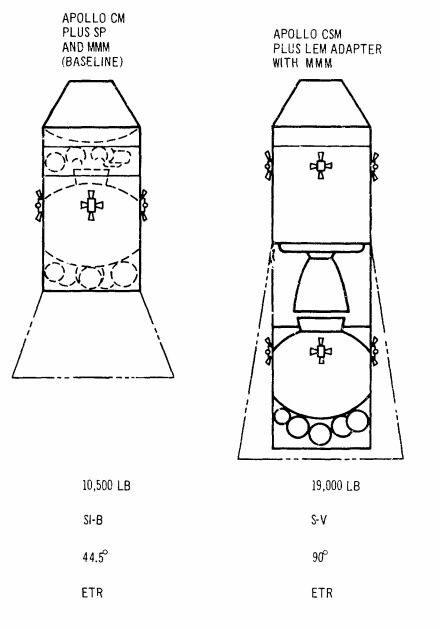

MORL Phase IIb examined the utilization of the MORL for space research in the 1970s. Subcontractors included:
Eclipse-Pioneer Division of Bendix, stabilization and control
Federal Systems Division of IBM, communications, data management, and ground support systems
Hamilton Standard Division of the United Aircraft Corporation, environmental control/life support
Stanford Research Institute, priority analysis of space- related objectives
Bissett-Berman, oceanography
Marine Advisors, oceanography
Aero Services, cartography and photogrammetry
Marquardt, orientation propulsion
TRW, main engine propulsion.
The original MORL program envisioned one or two Saturn IB and three Titan II launches. Crew would be 6 to 9 Astronauts. After each Gemini docked to the MORL at the nose of the adapter, the crew would shut down the Gemini systems, put the spacecraft into hibernation, and transfer by EVA to the MORL airlock. The Gemini would then be moved by a small manipulator to side of the station to clear docking adapter for arrival of the next crew."

"Docking was to have 3 ports, all Nose Dock config, with spacecraft modifications totaling +405 lbs over the baseline Gemini spacecraft (structure beef-up, dock provisions, added retro-rockets, batteries, a data link for rendezvous, temp. control equip. for long-term, unoccupied Gemini storage on-orbit and removal of R&D instruments)."
"Later concepts including docking a Saturn-IB launched space telescope to MORL. At 4 meter diameter and 15 meter long, this would be the same size as the later Hubble Space Telescope. The crew would have to make EVA's to recover the film from the camera.
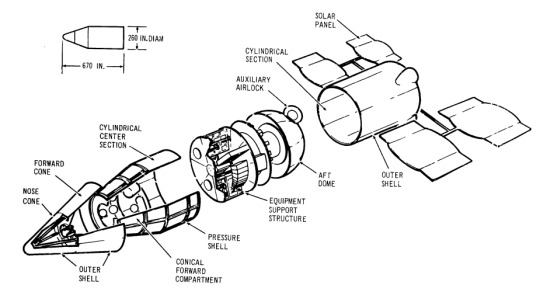
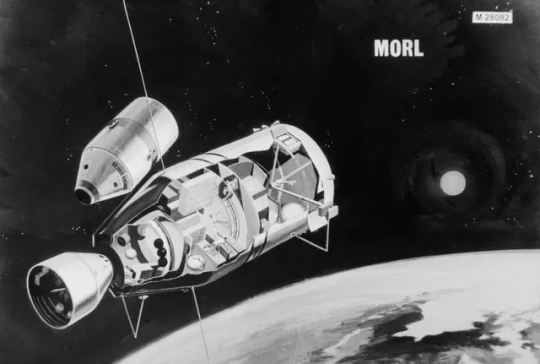
In 1965 Robert Sohn, head of the Technical Requirements Staff, TRW Space Technology Laboratories, proposed a detailed plan for early manned flight to Mars using MORL. The enlarged MORL-derived mission module would house six to eight men and be hurled on a Mars flyby by a single Saturn MLV-V-1 launch. MORL-derived Mars mission modules cropped up in other Douglas Mars studies until superseded by the 10-m diameter Planetary Mission Module in 1969.

MORL/Space Telescope
Why was MORL never launched ?
NASA had a need for a Space Station and MORL was little, easy and cheap. But NASA had more ambitious plans, embodied in the Apollo Applications Orbital Workshop (later called Skylab)."
-information from astronautix.com: link
source, source, source
NARA: 6375661, S66-17592
Posted on Flickr by Numbers Station: link
#Manned Orbital Research Laboratory#MORL#Space Station#Gemini#Gemini Program#Project Gemini#Apollo CSM Block II#Apollo Program#Saturn IB#Saturn I#S-IV#S-IVB#Apollo Applications Program#Cancelled#Study#1962#June#1965#my post
80 notes
·
View notes
Text
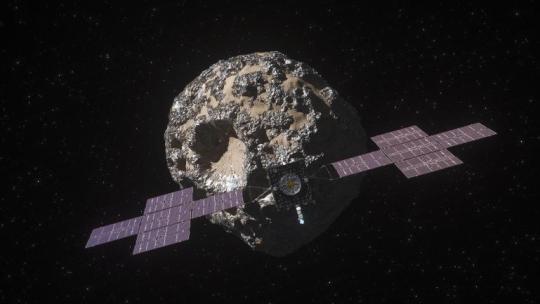
Let's Explore a Metal-Rich Asteroid 🤘
Between Mars and Jupiter, there lies a unique, metal-rich asteroid named Psyche. Psyche’s special because it looks like it is part or all of the metallic interior of a planetesimal—an early planetary building block of our solar system. For the first time, we have the chance to visit a planetary core and possibly learn more about the turbulent history that created terrestrial planets.
Here are six things to know about the mission that’s a journey into the past: Psyche.

1. Psyche could help us learn more about the origins of our solar system.
After studying data from Earth-based radar and optical telescopes, scientists believe that Psyche collided with other large bodies in space and lost its outer rocky shell. This leads scientists to think that Psyche could have a metal-rich interior, which is a building block of a rocky planet. Since we can’t pierce the core of rocky planets like Mercury, Venus, Mars, and our home planet, Earth, Psyche offers us a window into how other planets are formed.

2. Psyche might be different than other objects in the solar system.
Rocks on Mars, Mercury, Venus, and Earth contain iron oxides. From afar, Psyche doesn’t seem to feature these chemical compounds, so it might have a different history of formation than other planets.
If the Psyche asteroid is leftover material from a planetary formation, scientists are excited to learn about the similarities and differences from other rocky planets. The asteroid might instead prove to be a never-before-seen solar system object. Either way, we’re prepared for the possibility of the unexpected!
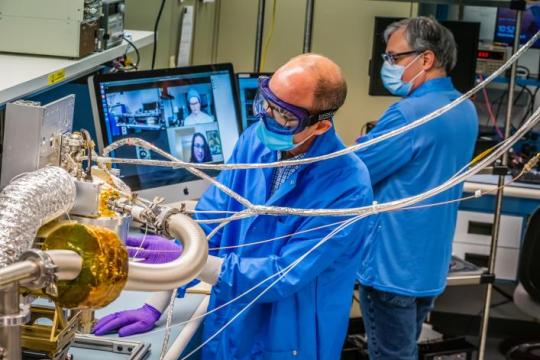
3. Three science instruments and a gravity science investigation will be aboard the spacecraft.
The three instruments aboard will be a magnetometer, a gamma-ray and neutron spectrometer, and a multispectral imager. Here’s what each of them will do:
Magnetometer: Detect evidence of a magnetic field, which will tell us whether the asteroid formed from a planetary body
Gamma-ray and neutron spectrometer: Help us figure out what chemical elements Psyche is made of, and how it was formed
Multispectral imager: Gather and share information about the topography and mineral composition of Psyche
The gravity science investigation will allow scientists to determine the asteroid’s rotation, mass, and gravity field and to gain insight into the interior by analyzing the radio waves it communicates with. Then, scientists can measure how Psyche affects the spacecraft’s orbit.
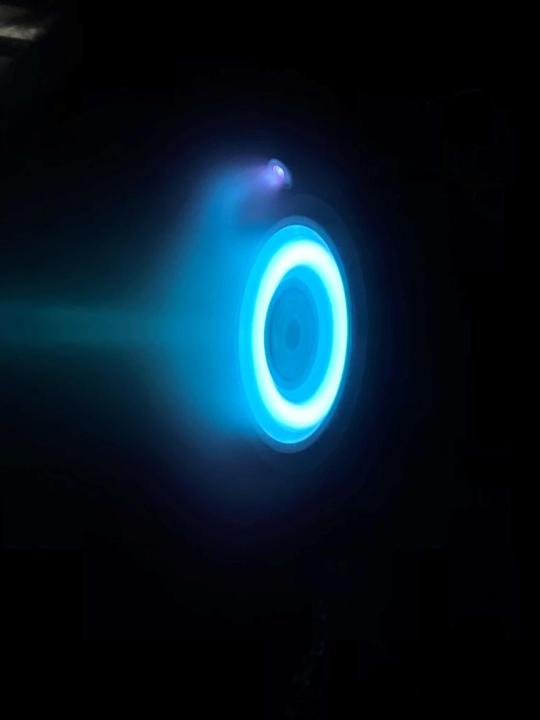
4. The Psyche spacecraft will use a super-efficient propulsion system.
Psyche’s solar electric propulsion system harnesses energy from large solar arrays that convert sunlight into electricity, creating thrust. For the first time ever, we will be using Hall-effect thrusters in deep space.
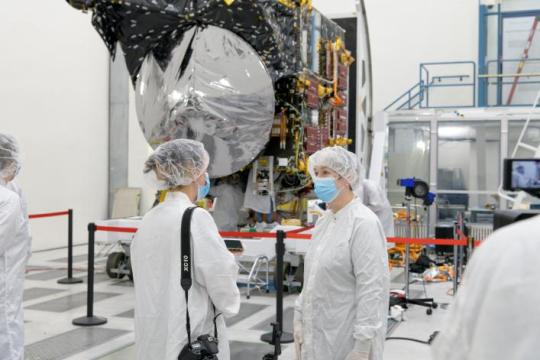
5. This mission runs on collaboration.
To make this mission happen, we work together with universities, and industry and NASA to draw in resources and expertise.
NASA’s Jet Propulsion Laboratory manages the mission and is responsible for system engineering, integration, and mission operations, while NASA’s Kennedy Space Center’s Launch Services Program manages launch operations and procured the SpaceX Falcon Heavy rocket.
Working with Arizona State University (ASU) offers opportunities for students to train as future instrument or mission leads. Mission leader and Principal Investigator Lindy Elkins-Tanton is also based at ASU.
Finally, Maxar Technologies is a key commercial participant and delivered the main body of the spacecraft, as well as most of its engineering hardware systems.

6. You can be a part of the journey.
Everyone can find activities to get involved on the mission’s webpage. There's an annual internship to interpret the mission, capstone courses for undergraduate projects, and age-appropriate lessons, craft projects, and videos.
You can join us for a virtual launch experience, and, of course, you can watch the launch with us on Oct. 12, 2023, at 10:16 a.m. EDT!
For official news on the mission, follow us on social media and check out NASA’s and ASU’s Psyche websites.
Make sure to follow us on Tumblr for your regular dose of space!
#Psyche#Mission to Psyche#asteroid#NASA#exploration#technology#tech#spaceblr#solar system#space#not exactly#metalcore#but close?
2K notes
·
View notes
Text
On Monday, Reuters reported my discovery that Russia is building what appears to be the first deployment site for its experimental nuclear-powered cruise missile, the Burevestnik—which the United States calls the SSC-X-9 Skyfall. The facility is almost complete, suggesting that the new missile may enter service with the Russian Strategic Rocket Forces soon.
The site is located at a nuclear warhead storage facility, reportedly called Vologda-20, roughly 400 miles from Russia’s borders with Finland and Estonia, and contains nine fixed launch positions supported by missile-handling facilities and nuclear warhead storage bunkers. With the launch positions, missiles, and warheads all present at the same site, it’s likely that the Burevestnik will be an on-alert missile ready to launch at a moment’s notice.
There is significant hype surrounding the Burevestnik: U.S. officials have decried Russia’s development of “radiation-spewing, nuclear-powered cruise missiles” and called the system a “flying Chernobyl.” Unlike standard cruise missiles, which are powered by jet engines, the Burevestnik uses an unshielded nuclear reactor for propulsion. This gives it the ability to fly almost unlimited distances, at least in theory.
If deployed, the Burevestnik would be the first missile of its kind actually fielded. The United States explored the concept of a nuclear-powered missile in the 1950s and 1960s under the banner of Project Pluto but canceled the project due to concerns about the danger the system would pose to the United States’ own population. Such concerns were validated in 2019 when a Burevestnik exploded during a test and killed several Russian missile scientists.
The Burevestnik’s advanced propulsion system and virtually unlimited range may allow Russia to use the missile in radical new ways. In 2020, the United Kingdom’s Chief of Defense Intelligence General James Hockenhull told reporters that Moscow was testing a nuclear-powered cruise missile system with “global reach [that] would allow attack from unexpected directions” and provide a “near indefinite loiter time,” meaning the missile could fly around a designated target for long periods of time before attacking, potentially even circumnavigating the Earth.
The reference to loitering has raised concerns that Russia might launch Burevestnik missiles in a crisis, which could then cruise near U.S. and NATO targets while waiting for instructions. This would allow Moscow to strike quickly once orders are given, significantly shortening the amount of time NATO would have to react to Russian aggression. Some analysts have even speculated that Russia could fly Burevestniks over European territory as a signal before turning around and flying back, potentially intimidating NATO allies into backing down and ceding to Russian demands.
These assessments of the Burevestnik’s potential capabilities, however, are technically infeasible. Russia is unlikely to use the new missile in this way because two factors limit its capabilities and potential uses: range and visibility.
Despite claims from the Russian Ministry of Defense that the missile’s range is effectively unlimited, there are significant costs to flying one great distances or loitering for long periods of time. Missiles can generally find their location by communicating with satellites, but satellite signals can be easily jammed or spoofed. To ensure a missile can operate without relying on satellites, it is also equipped with inertial navigation, which finds the missile’s position through the process of dead reckoning. Consulting mechanical accelerometers and gyroscopes, the missile can determine its position by closely recording its speed and direction and the length of its flight.
But over time, small errors in the missile’s guidance system compound, similar to how a mechanical watch will eventually stop keeping time. Thus, having a missile fly for long periods in a loitering pattern would generate serious risk of it flying off course and missing its target.
Russia could attempt to guide its missiles remotely, but the limited range of Russian communication systems—coupled with the small problem of the curvature of the Earth—drastically restricts the area in which Russia could actively guide a missile. It is unlikely that Russia could send missiles far from home and still be able to reliably communicate with them. If Russia eventually did install remote guidance, the missiles would still be vulnerable to electronic warfare activities.
This does not mean that the Burevestnik’s extended range is useless, however. Cruise missiles are effectively disposable airplanes; like airplanes, their range is determined by fuel-efficiency factors. The altitude at which the missile flies presents an important trade-off: range versus detection. The higher a traditional jet engine-powered missile flies, the more fuel efficient it becomes; because the air is thinner, there is less drag. But cruise missiles flying at higher altitudes are also easier for radar to detect. Conversely, dropping altitude allows missiles to more easily avoid detection, but the thicker air requires jet engines to burn more fuel, significantly shortening the missiles’ range.
The major advantage of the Burevestnik’s nuclear-powered engine is that it does not need to make trade-offs between fuel efficiency and detectability. For example, whereas the United States’ Tomahawk missile, with a range of 770 to 1,550 miles, cannot reach intercontinental targets, the Burevestnik’s engine could theoretically run for days, allowing the missile to fly from its base in Russia to targets even in the United States, all while flying low to avoid radar. Despite the Burevestnik’s reactor enabling such a plan, guiding the missile accurately to the target would still be an immense challenge.
Although the Burevestnik may be more difficult to detect, it is not invisible. Cruise missiles are stealthier than other missiles because they generate strong heat signatures only at the moment of their launch. After that, the heat signature is smaller—not undetectable, but more difficult to track, especially by satellites in space that must see through an often-cloudy atmosphere. For the Burevestnik, however, this advantage dissipates the longer Russia lets it loiter. Placing the missile on in-air standby for long periods of time would give the NATO land-, sea-, air-, and space-based air-defense assets more time to detect the missile and maneuver into place to intercept it.
Russia could have attempted to mitigate this problem by making the launch system mobile, allowing it to hide where the missile originated, but it has not done so. Instead, Russia is building fixed launch sites, which will be closely watched by NATO reconnaissance capabilities for any sign of launch. This makes Burevestnik flights easier to predict and easier to track.
Because of the problems with communications and accuracy, the Burevestnik likely does not have the capability to truly surprise NATO. A better way of understanding the Burevestnik is as a straightforward way to penetrate U.S. and NATO air defenses, capable of flying more-or-less directly toward its target at extreme low altitudes.
The real problem with Burevestnik is that Russia may be compelled to launch it preemptively in a crisis because its fixed deployment site is vulnerable to attack. Moreover, the missile has a very long travel time to intercontinental targets compared to intercontinental ballistic missiles, requiring many hours rather than minutes. A Russian leader may feel pressure to launch a Burevestnik before the United States has a chance to maneuver its air defense assets into place and before the launch site can be destroyed by NATO missiles—including, for example, the conventional hypersonic missiles the United States will deploy to Germany in 2026.
Although Russian leaders may feel pressured to use the Burevestnik preemptively, there is no reason why Moscow could not be deterred from initiating a nuclear war using the missile. NATO states can try to prevent this by investing in military infrastructure that could credibly survive a Russian nuclear first strike and respond, making their targets less tempting in the first place. This means adding dispersion and redundancy into NATO defenses at sites that would be early targets, such as radar and airfields—especially in the United States, where assets have never been credibly threatened by hard-to-detect Russian systems.
The Burevestnik is not a wonder weapon, and the challenges it poses for NATO security are neither new nor unmanageable. It may seem scary on paper, but the technical infeasibility of its mission limits its threat. Much of the hype around the missile stems from Russian saber-rattling about its capabilities. In this context, perhaps one of the best things NATO can do to stay strong in a crisis is to call out this weapon for what it is—a terror weapon, not a silver bullet.
So far, the only people the Burevestnik has killed are its own designers. Combating Russian propaganda will help keep it that way.
7 notes
·
View notes
Text

55 years ago... Rolex on Apollo 13 ! Remembering the April 1970 mission, as the Apollo 13 crew wore NASA-issued Omega Speedmaster 105.012-66 CB chronographs: James Lovell wore NASA #70 , Fred Haise wore NASA #68, Jack Swigert wore NASA #69 and his personal Rolex GMT-master 1675 Pepsi pilot watch. On April 15, Command Module Pilot Jack Swigert timed the 14 seconds LM DPS burn ( Lunar Module – Descent Propulsion System) using James Lovell’s Speedmaster as they knew it was the most recent serviced chronograph! After a 4000 Km transfer from Samoa to Hawaii, the Apollo 13 crew was meet by their wives & President Richard Nixon. Note the Rolex GMT-master "Pepsi" pilot watch on Swigert's lefthand wrist. In October 1970, during a visit to Switzerland, Swigert offered the space-flown steel Rolex GMT-master 1675 "Pepsi" pilot watch and was offered a Gold version by Rolex PR René-Paul Jeanneret. Swigert wore the watch for the rest of his life and it can be seen in his official NASA portrait S71-52266. (Photos: NASA)
#Apollo13#Astronaut#Rolex#GMT-master#1675#Pepsi#361#chronograph#MoonwatchUniverse#NASA#Omega#Speedmaster#montres#military#US Navy#USAF#Hawaii#Honolulu#Rolex watches#Swiss-made#spaceflight#Zulu time
4 notes
·
View notes
Text
NASA Transmits Hip-Hop Song to Deep Space for First Time
Gerelle Q. Dodson in a news post for NASA:
The stars above and on Earth aligned as an inspirational message and lyrics from the song "The Rain (Supa Dupa Fly)" by hip-hop artist Missy Elliott were beamed to Venus via NASA's DSN (Deep Space Network). The agency's Jet Propulsion Laboratory in Southern California sent the transmission at 10:05 a.m. PDT on Friday, July 12.
As the largest and most sensitive telecommunication service of NASA's Space Communications and Navigation (SCaN) program, DSN has an array of giant radio antennas that allow missions to track, send commands, and receive scientific data from spacecraft venturing to the Moon and beyond. To date, the system has transmitted only one other song into space, making the transmission of Elliott's song a first for hip-hop and NASA.
Now do Wu-Tang. For the children. ... who are in outer space.
8 notes
·
View notes
Text




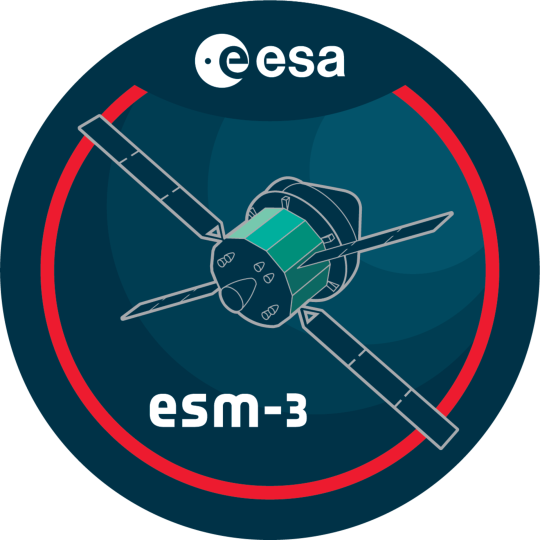



ESA delivers again: ESM-3 departs for US to power Artemis III
ESA’s third European Service Module (ESM-3), for NASA’s Artemis III mission, has departed from the Airbus facility in Bremen, Germany, and will soon leave Europe on its way to the United States. This marks a critical milestone in Europe's continued contribution to humankind’s return to the Moon.
Manufactured in Italy, assembled in Germany, and built with components sourced from over 20 companies across more than 10 European countries, ESM-3 embodies the spirit of international collaboration. The module will now make its way to NASA’s Kennedy Space Center port aboard the transport ship Canopée, a journey that will take approximately 12 days across the Atlantic Ocean.
The European Service Module is an essential component of NASA’s Orion spacecraft, providing power, propulsion and life-support systems for astronauts during their deep space missions. This marks the third such module delivered by ESA, following the successful Artemis I mission and the ongoing preparations for Artemis II.
The journey of ESM-3 began in Turin, Italy, at Thales Alenia Space, where the module’s structural backbone was constructed. This complex structure supports 11 km of wiring, 33 engines, four tanks of propellant and solar arrays that can generate enough electricity to power two households.
Following assembly in Bremen, the module’s main engine—an engine with a legacy of nine Space Shuttle missions—was installed earlier this year.
Upon arrival at Kennedy Space Center, ESM-3 will be integrated with the Crew Module Adapter and the Crew Module itself. Rigorous testing will follow to ensure that everything is ready for the Artemis III mission, which aims to land astronauts on the Moon for the first time since the Apollo era.
This departure represents a key step in ESA’s partnership with NASA, demonstrating Europe's commitment to advancing human exploration beyond Earth.
10 notes
·
View notes